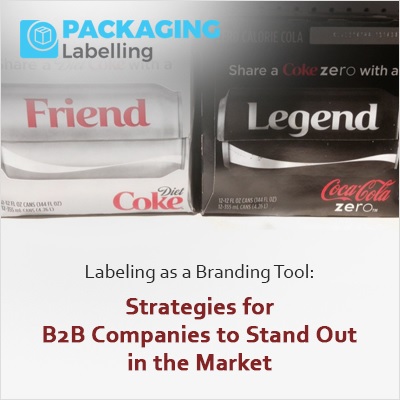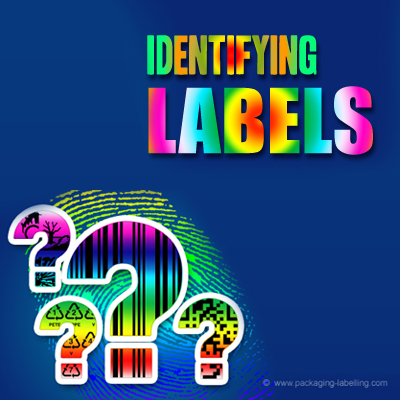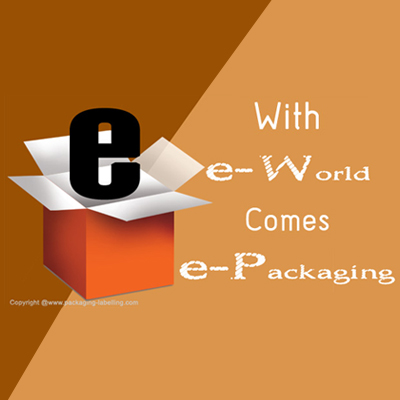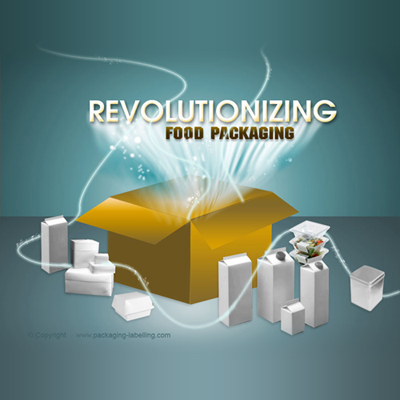Labeling as a Branding Tool: Strategies for B2B Companies to Stand Out in the Market

In the competitive realm of B2B industries, forging a unique brand identity is imperative for success. Despite the common association of branding with consumer-facing businesses, B2B companies can derive substantial advantages by utilizing labeling as a potent tool to elevate brand recognition and foster customer loyalty. This article delves into impactful strategies for B2B enterprises to carve their niche in the market through deliberate and strategic labeling.
1. Design Elements that Speak Volumes:
In the intricate interplay of B2B branding, the visual language communicated through packaging design can be a powerful determinant of a company's success. Among the myriad design elements, three stand out as particularly influential: logo placement, color psychology, and font choices. In this exploration, we delve into how these elements can be strategically employed to enhance brand visibility and convey professionalism.
Logo Placement and Visibility: Enhancing Brand Recognition
In the essence of brand identity lies the company logo—a visual symbol that encapsulates the essence of the business. The strategic placement of this logo on the packaging is not merely aesthetic but serves as a potent identifier, etching the brand into the minds of clients and partners. Successful B2B brands understand the importance of ensuring their logos are prominently displayed, contributing to instant recognition.
The intricacies of a well-designed and memorable logo cannot be overstated. Its placement on packaging becomes a crucial aspect of brand visibility. Whether adorning the center stage or subtly integrated into the design, the logo should command attention and leave an indelible mark. Examining case studies of B2B brands that have mastered logo placement provides valuable insights into effective strategies for enhancing brand recognition.
Color Psychology in B2B Labeling: Creating Emotional Connections
Colors wield a profound influence on human emotions and perceptions, making them invaluable tools in the arsenal of B2B branding. The psychological impact of colors is a nuanced realm, and B2B companies can harness this power by choosing hues that align with their brand personality and values. Trust, reliability, innovation—these attributes can be subtly conveyed through a carefully curated color palette.
Consider the trustworthiness associated with blues and the vibrancy evoked by oranges. These emotional connections can be strategically utilized in B2B labeling to reinforce brand attributes. Examining case studies or real-world examples of successful B2B brands that have effectively employed color psychology provides a tangible understanding of how color choices can influence brand perception.
Font and Typography Choices: Conveying Professionalism and Consistency
Beyond mere readability, font and typography contribute significantly to the overall professionalism and tone of a brand. The choice of fonts becomes a linguistic element, speaking to the audience in a manner that resonates with the brand's identity. Consistency in font usage across various product lines is not just a matter of aesthetics but a crucial factor in maintaining a cohesive brand image.
In the world of B2B, where professionalism is paramount, the right fonts convey a sense of authority and reliability. Whether sleek and modern or classic and traditional, the chosen typography sets the tone for the brand. Exploring the impact of font and typography on brand perception, along with insights into maintaining consistency, provides B2B companies with a roadmap to creating a visually cohesive brand identity.
In the symphony of B2B branding, the orchestration of logo placement, color psychology, and font choices creates a harmonious visual identity that resonates with clients and partners. By strategically placing logos for instant recognition, employing colors to evoke emotional connections, and choosing fonts that convey professionalism, B2B companies can craft a compelling narrative through their packaging. This visual storytelling not only enhances brand visibility but also contributes to the enduring success of B2B enterprises in a competitive marketplace.
2. Crafting Narratives in B2B: Storytelling Through Packaging
In the fast-paced world of B2B commerce, where transactions are often driven by logic and functionality, there lies a unique opportunity for companies to stand out by integrating storytelling into their packaging. The art of storytelling, traditionally associated with consumer brands, is a potent tool that B2B enterprises can leverage to connect with clients, partners, and stakeholders on a deeper level. This article explores the transformative power of storytelling through packaging and how it can be a game-changer for B2B brands.
Crafting a Compelling Narrative: Unveiling the Brand Story
Central to narrative crafting through packaging is the capacity to reveal the brand's story—the journey, values, and mission that shape its identity. In the realm of B2B, packaging serves as a canvas for companies to articulate not only what they do but also why it holds significance. Through the creation of a compelling narrative, businesses can cultivate a sense of connection and resonance with their audience, elevating a transactional relationship into a meaningful partnership.
Illustrating this concept with real-world examples, showcasing how B2B companies have successfully integrated their brand stories into packaging, provides actionable insights. From the inception of the business to overcoming challenges, the narrative can be a powerful tool for creating a memorable and emotionally engaging experience for recipients.
Highlighting Industry Expertise: Establishing Authority and Credibility
In B2B, where trust and credibility are paramount, storytelling can be used to showcase industry expertise. Packaging becomes an opportunity to communicate the company's deep knowledge, experience, and commitment to excellence. Whether through certifications, awards, or succinct narratives, B2B brands can establish themselves as industry leaders, reinforcing the trust that clients and partners place in their products or services.
Case studies of B2B enterprises effectively using packaging as a means to communicate their industry expertise offer valuable lessons. By highlighting how packaging can be a conduit for conveying technical prowess, companies can inspire confidence and position themselves as trusted authorities within their respective sectors.
Showcasing Innovation and Quality: Packaging as a Symbol of Excellence
Packaging transcends its role as a mere protective shell; it serves as a tangible manifestation of a company's dedication to innovation and quality. In the realm of B2B, storytelling can be harnessed to spotlight the meticulous processes, cutting-edge technologies, and unwavering commitment invested in the production of products or services. This narrative transforms into a promise—a pledge to excellence that becomes apparent from the moment the package is opened.
Examining examples of B2B brands using packaging to symbolize innovation and quality allows businesses to grasp the tangible impact of such storytelling. Whether through innovative design elements, sustainable materials, or quality assurance labels, packaging becomes a conduit for communicating a dedication to delivering superior products.
In a B2B landscape often dominated by facts and figures, the incorporation of storytelling through packaging introduces a human element—a narrative that resonates with the emotions and aspirations of clients and partners. By crafting compelling narratives, unveiling brand stories, highlighting industry expertise, and showcasing innovation and quality, B2B enterprises can transform their packaging into more than just a vessel for products—it becomes a vehicle for meaningful connections and lasting impressions. In doing so, B2B brands can transcend the transactional and establish enduring relationships built on shared values and compelling narratives.
3. Forging Unity in Diversity: Creating a Consistent B2B Brand Image through Packaging
In the dynamic world of B2B, where versatility often reigns supreme, establishing a consistent brand image across diverse product lines can be a challenging yet essential undertaking. The unifying thread that ties together these varied offerings lies in the packaging—an often underestimated powerhouse of brand identity. This article explores strategies for B2B enterprises to create and maintain a cohesive brand image through thoughtful packaging design, ensuring that each product contributes harmoniously to the overarching narrative.
Uniformity Across Product Lines: The Backbone of Brand Consistency
In the realm of B2B, where a single business may offer an array of products or services, maintaining a consistent visual identity is key. Packaging becomes the canvas upon which the brand story unfolds, providing an opportunity to instill uniformity across diverse product lines. Delve into the importance of standardized design elements—colors, logos, and overall aesthetics—and how they contribute to a seamless brand experience.
Drawing inspiration from B2B brands that have successfully achieved uniformity across their product lines, this section illustrates the practical application of consistent packaging design. Whether through a unifying color palette or a standardized logo placement, these examples serve as beacons for B2B companies seeking to create a cohesive brand image.
Adapting to Different Markets: Tailoring without Compromising Identity
B2B enterprises often operate in various markets, each with its unique nuances and preferences. While uniformity is crucial, adaptability is equally important. Explore strategies for tailoring packaging to suit different regional or industry-specific markets without diluting the core brand identity. From cultural considerations to market-specific trends, packaging can be a versatile tool for B2B brands to resonate with diverse audiences.
Real-world case studies of B2B companies adept at adapting their packaging to different markets provide actionable insights. By showcasing examples of successful cross-market packaging strategies, businesses can learn how to strike a delicate balance between consistency and adaptability.
Consistency in Digital and Physical Presence: Bridging the Divide
In an increasingly digital business landscape, the consistency of a brand's presence across online platforms and physical products is paramount. Explore the interplay between digital and physical branding, emphasizing the importance of maintaining a cohesive identity. Discuss how B2B companies can ensure that their packaging aligns seamlessly with their online presence, reinforcing the brand image across all touchpoints.
Illustrating this point with examples of B2B brands that have effectively bridged the digital-physical divide, this section emphasizes the importance of a holistic brand strategy. Whether through e-commerce platforms or traditional packaging, the goal is to present a unified brand identity that resonates with clients and partners alike.
In the intricate interplay of B2B branding, where diversity and adaptability are the norm, consistency becomes the linchpin holding the brand narrative together. By embracing uniformity across product lines, adapting intelligently to different markets, and ensuring a seamless digital-physical transition, B2B enterprises can wield packaging as a powerful tool for creating and maintaining a consistent brand image. In doing so, they not only enhance recognition but also foster trust and loyalty among their diverse clientele.
Conclusion:
In the dynamic B2B realm, consistency in packaging design emerges as a powerful ally. It unifies diverse product lines, adapts seamlessly to different markets, and bridges the digital-physical gap. This consistency is more than visual; it's a commitment to reliability and quality. Real-world examples showcase its impact, demonstrating how B2B enterprises can inspire trust and loyalty. In a world of complexity, a consistently presented brand becomes a reliable partner, fostering enduring connections and standing out in the ever-evolving business landscape.









